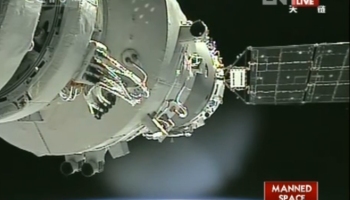 Chinese astronauts Jing Haipeng (L) and Chen Dong meet the media at a press conference at the Jiuquan Satellite Launch Center in northwest China, October 16, 2016. The two male astronauts will carry out the Shenzhou-11 mission. The Shenzhou-11 manned spacecraft will be launched at 7:30 am October 17, 2016 Beijing Time (2330 GMT Oct. 16). Photo: Xinhua
Chinese astronauts Jing Haipeng (L) and Chen Dong meet the media at a press conference at the Jiuquan Satellite Launch Center in northwest China, October 16, 2016. The two male astronauts will carry out the Shenzhou-11 mission. The Shenzhou-11 manned spacecraft will be launched at 7:30 am October 17, 2016 Beijing Time (2330 GMT Oct. 16). Photo: Xinhua https://youtu.be/FUI6U6YH6lc
 Both astronauts introduced at press conference
Both astronauts introduced at press conference
China to launch Shenzhou-11 manned spacecraft on Oct 17
The Shenzhou-11 manned spacecraft will be launched at 7:30 a.m. Monday Beijing Time, China's manned space program spokesperson said Sunday.
The spaceship will take two male astronauts Jing Haipeng and Chen Dong into space, said Wu Ping, deputy director of China's manned space engineering office, at a press conference at the Jiuquan Satellite Launch Center.
The mission will be carried out with a Long March-2F carrier rocket, Wu said.
The spacecraft will dock with orbiting space lab Tiangong-2 within two days, and the astronauts will stay in the space lab for 30 days, she said.
After that the Shenzhou-11 spaceship will separate with Tiangong-2 and return to Earth within one day, Wu said.
The mission aims to transport personnel and materials between Earth and Tiangong-2, and examine rendezvous, docking and return technologies.
During the mission, the spacecraft will form a complex with Tiangong-2. The complex's capabilities of supporting astronauts' life, work and health, and astronauts' abilities for carrying out flight missions will be tested, Wu said.
Other objectives include conducting aerospace medical experiments, space science experiments and in-orbit maintenance with human participation, along with activities to popularize scientific knowledge, she added.
Several technical alterations have been made to Shenzhou-11, though its main functions and technical parameters remain basically the same with Shenzhou-10, Wu said.
To meet the needs of this mission, the orbit control strategy and flight procedures have been adjusted to adapt Shenzhou-11 to the change of the rendezvous, docking and return orbit from 343 kilometers to 393 kilometers from Earth.
The layout of cargo loading has been adjusted to enhance transportation capabilities for the mission.
To further improve the spacecraft's reliability and astronauts' safety, wide-beam relay telecommunications devices have been equipped, which will significantly expand the scope of telemetry, tracking and control, as well as improve the space-ground communication support capabilities when the posture of the spacecraft is changing rapidly.
To verify future space technologies and meet the demand for prolonging the service life of rendezvous, telemetry and tracking devices in future space stations, such devices in Shenzhou-11 have been upgraded, according to Wu.
Certain technical alterations have also been made to the carrier rocket, she said. - Xinhua
Achievement of China's space industry in 60 years
Related posts:
Sep 15, 2016 ... The graphics shows China will launch the Tiangong-2 space lab from the
Jiuquan ..... Tiangong-2 space lab draws global praise, with the.
Sep 17, 2016 ... NASA closely watches Tiangong-2 launch. The space industry has paid close
attention as China sent the Tiangong-2 lab into space. NASA is ...




No comments:
Post a Comment
rightwaystosuccess@gmail.com